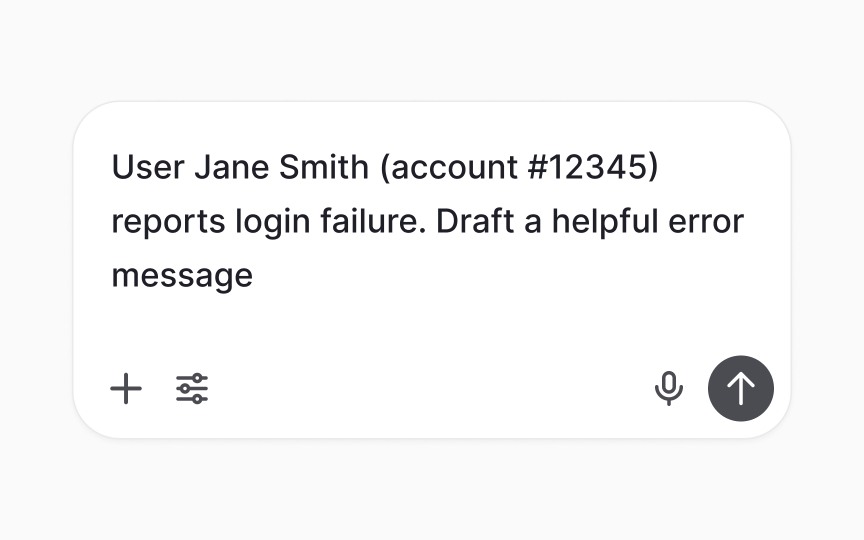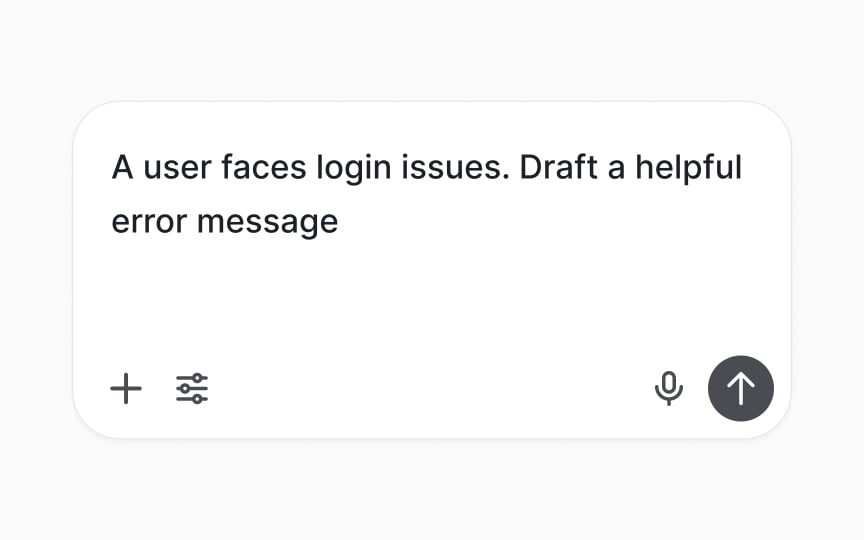Ethics, Limitations, and Best Practices
Navigate the ethical complexities of AI integration while building frameworks that balance innovation with responsibility and human oversight.
Working with AI isn't just about getting great outputs. It's about using this powerful tool responsibly. Every prompt you write has the potential to reveal biases, expose sensitive information, or produce content that could harm others.
AI learns from human-created data, which means it can pick up and amplify our worst assumptions. A seemingly innocent request for user personas might default to certain demographics. An analysis might reinforce existing biases in your data. Sometimes AI confidently provides wrong information, and catching these moments requires sharp critical thinking.
Privacy gets tricky, too. That customer feedback you're analyzing? The code snippet you're debugging? Each prompt creates a record, and you need to know what's safe to share. Organizations are starting to require documentation of AI usage, and regulations are emerging fast. The real skill lies in developing good judgment about when to rely on AI and when human insight is irreplaceable. It's about building guardrails that let you work efficiently while protecting what matters most.
The prompting framework helps catch bias during the evaluation stage. After getting any output, ask: Who's missing? What assumptions did AI make? Would this work for different user groups?
Use iteration to expose patterns, and if certain demographics, abilities, or perspectives never appear, you've found bias. This systematic approach works better than hoping to notice problems. Fix bias by being explicit in prompts.
Instead of "create user scenarios," try "create scenarios including users with disabilities, limited tech access, and diverse cultural backgrounds." Specific requests get inclusive results.
Ethical frameworks guide consistent
Here are some guidelines:
- Start with core values. What matters most? User privacy? Transparency? Fairness? Write these down. They anchor every decision. From these values, build specific guidelines. If transparency matters, you might require labeling all AI-generated
content . - Use decision trees for common scenarios. "Can I analyze customer feedback with AI?" Your framework answers: First, anonymize data, check privacy policies, ensure human review, document the process. Clear steps remove guesswork.
- Include diverse voices when building frameworks. Engineers focus on data security. Designers worry about bias. Support teams want transparency. Each perspective strengthens your guidelines.
The context helps here. When you include ethical considerations in your prompts, AI responds more appropriately. However, static frameworks quickly become outdated as AI capabilities expand and regulations shift. That's why scheduling quarterly reviews keeps your guidelines aligned with current realities and emerging best practices.
Create templates that capture:
- Task goal and AI's role
- Prompts used (especially successful ones)
- Verification methods applied
- Human modifications made
This aligns with the prompting framework's Iterate principle. Document how prompts evolved and why and save both failed and successful attempts. Others learn from your experiments.
Share documentation openly. Use collaborative tools where teams can comment and improve. This transparency protects everyone and speeds up learning.
Pro Tip: Create a prompt library from documented successes for team reuse.
Human review catches
- Set alerts for sensitive words.
- Flag outputs that seem unusual.
- Create simple checklists for common tasks.
These tools support human judgment without replacing it.
Every prompt could expose private data. Smart prompting gets good
Never include real customer data. Replace "Jane Smith, account #12345, can't log in" with "User has login problems." The AI still helps without seeing private details. This protects customers and follows privacy laws.
Company secrets need protection too. Don't share unreleased product names, proprietary code, or strategic plans. When you need help with confidential work, make it generic. "How do I improve authentication?" beats sharing your actual security system.
Different AI tools handle data differently. Consumer tools might use your prompts for training. Enterprise tools usually promise data isolation. Pick the right tool for each task. Read privacy policies carefully. Create
Pro Tip: Before sending any prompt, ask: would I post this publicly?
- Know your industry's rules. Healthcare has HIPAA for AI-assisted diagnosis. Finance tracks automated decisions for fair lending. Education protects student privacy. Even without AI-specific laws, data protection rules apply. GDPR requires explaining AI decisions affecting EU users.
- Control who uses which tools. Not everyone needs every AI capability. Create access levels based on training and job needs. Track who uses what. This helps with compliance reports and reduces risks.
- Build AI workflows that can change easily. When regulations change, you should be able to update specific steps without starting over. Use
documentation templates that all teams follow. This consistency makes audits simpler. Meet with legal teams quarterly to stay current with new requirements.
Knowing
- AI matches patterns from training data. It doesn't truly understand anything. Ask about recent events or specialized topics, and it might make things up. It sounds confident even when wrong.
- "Hallucination" is AI's most dangerous limit. It creates false facts that sound real. Fake research citations. Made-up statistics. Events that never happened. This isn't broken AI. It's how these models work. Always verify facts, especially numbers, dates, and citations.
- Complex reasoning shows more limits. AI struggles with cause-and-effect, mathematical proofs, and logic that needs real understanding. Changing temperature settings makes outputs more creative or careful, but doesn't improve accuracy.
- AI can't truly feel or make ethical choices. It writes sympathetic messages by copying patterns, not from understanding. It lists ethical rules but can't handle real moral dilemmas. Keep humans in charge of decisions needing empathy or ethics.
Clear accountability keeps quality high as
- Start with clear ownership. Use RACI matrices: who's Responsible for accuracy? Accountable for results? Consulted on
content ? Informed of changes? This clarity prevents "the AI did it" excuses when problems happen. - Keep quality standards consistent. Don't accept lower quality just because AI helped. Set clear criteria: accuracy levels, brand voice, legal compliance. These standards apply whether humans write alone or AI assists.
- Create clear paths for reporting AI problems. When someone spots bias or
errors , they need to know where to report. Quick responses build trust. - Document incidents to prevent repeats. Include AI issues in normal incident handling.
- Record why you made decisions, not just what you decided. For big choices AI influenced, document: why you trusted its analysis, other options considered, how humans shaped the outcome. This protects you and helps teams learn.
Similar lessons

AI’s Role in Text Generation and Modification

Best Practices and Potential Pitfalls of AI Writing Tools




















